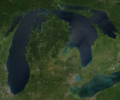This article needs additional citations for verification .(March 2024) |
Listed below are the largest ocean, lakes and seas in the Solar System and beyond includes single bodies of water or other liquid on or near the surface of a solid round body (terrestrial planet, planetoid, or moon).
Contents
Currently, cold surface bodies of liquid are found on two worlds in the Solar System, Earth and Saturn's moon Titan. [1] Earth is the only planet with liquid water on its surface. The other "oceans" are found under thick covers of surface ice. If both liquid and frozen water are counted, Earth ranks fifth in volume of its oceans. [2] Recent studies indicate a large underground saltwater ocean present on Ganymede, Jupiter’s largest moon, with estimated water volume eight times greater than Earth’s world ocean. [3]
The fourth largest of Jupiter’s moons, Europa, while smaller than Earth’s moon, ranks fourth in water volume, estimated to be twice as much as on Earth. [2] Latest analysis using data from NASA’s James Webb Space Telescope indicates that the carbon dioxide found on the icy surface of Europa likely originated in the subsurface ocean which could potentially be habitable. [4]
Scientists predict "oceans" beneath the ice of the Jupiter's moon Callisto's cratered surface and the south pole of Saturn's moon Enceladus. Saturn's moon Titan is also thought to have a salty subsurface ocean of water - as salty as the Dead Sea on Earth. [3] Additionally, research suggests that Saturn's moon Mimas might be hiding a liquid water ocean beneath its impact-battered surface. A subsurface ocean at Neptune's moon Triton is considered possible as well. Mysterious fault lines on dwarf planet Pluto may suggest that it has a hidden subsurface ocean. [3]
Lava lakes are found on Earth and Jupiter's moon Io. [5] Subsurface oceans or seas are suspected to exist on some of Saturn's other moons, the asteroid Ceres, the larger trans-Neptunian objects, and ice planets in planetary systems.
Recent analysis of the interior of Ganymede suggests that it and some of the other icy bodies may not have a single interior global ocean but several stacked ones, separated by different phases of ice, with the lowest liquid layer adjacent to the rocky mantle below. [6] [7]
In June 2020, NASA scientists reported that it is likely that exoplanets with oceans may be common in the Milky Way galaxy, based on mathematical modeling studies of their internal heating rates. The majority of such worlds would probably have subsurface oceans, similar to those of the icy moons Europa and Enceladus. [8] [9]









